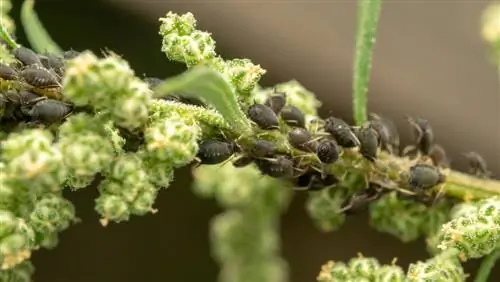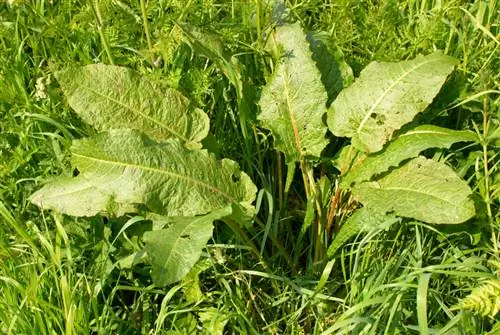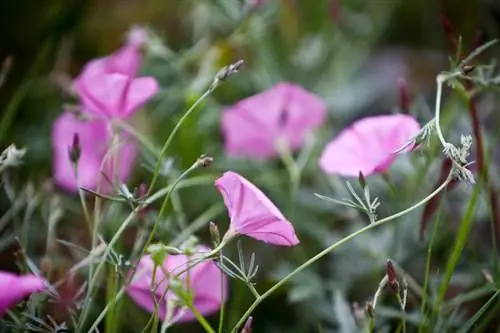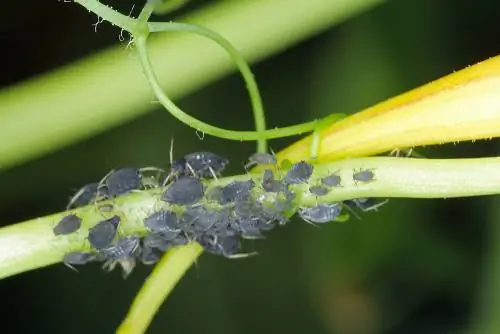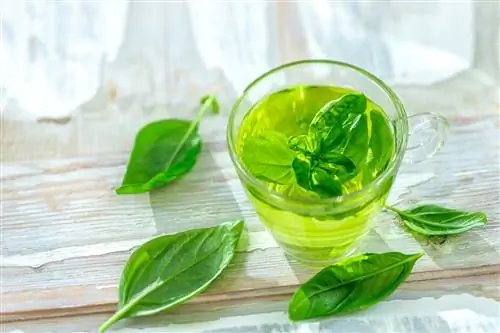- Author admin [email protected].
- Public 2023-12-16 16:46.
- Last modified 2025-06-01 06:02.
Many hobby gardeners are faced with the challenge of plant pests at least once. Sucking insects appear seemingly out of nowhere and spread en masse. However, many attempts at pest control come to nothing. What really works to combat black aphids?
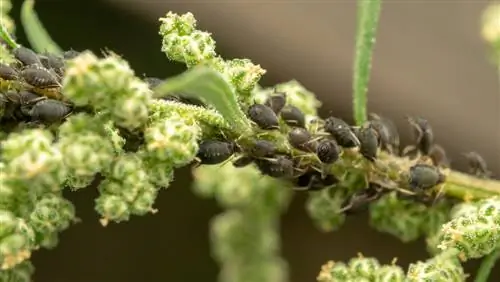
How do you effectively fight black aphids?
To combat black aphids, you can use predatory insects such as ladybirds, earwigs and parasitic wasps in the garden. Home remedies such as garlic, plant decoctions (e.g. from rhubarb, onion or nettle) and cleaning products such as soft soap, brandy vinegar or rapeseed oil-water mixtures can be used for houseplants.
Beneficial insects: remedies against black aphids
If you want to combat black aphids, the right products are important. There are a number of beneficial insects that attack aphid colonies in nature. This keeps the populations in check and creates a natural balance. You can use these helpers in your garden to combat pests naturally.
Ladybug

Ladybirds love aphids
These beetles are real aphid killers. When the adults wake up from their winter break in spring, they satisfy their cravings with an average of 50 aphids per day. Therefore, ladybugs can be observed in nature on heavily infested plants. Females lay their eggs here in spring, from which larvae hatch after a short time. These aphid lions capture around 400 to 600 aphids before pupation. The offspring of a single ladybird destroy more than 100,000 of these sap-sucking pests per season.
| Coloring | Number of points | Occurrences | |
|---|---|---|---|
| Asian ladybird | light yellow to dark red | mostly 19, partially fused to cover the body | originally Asia |
| Seven-spotted ladybug | red | 7 | Europe, Asia, North Africa |
| Checkerboard Ladybug | light yellow to intense yellow | 14, partially merged across the board | Europe, Asia |
| Four-spotted ladybug | yellowish to light red | variable, usually 4 black dots on the pronotum | Europe |
| Mushroom Ladybug | strong yellow | Evector wing: 22, pronotum: 5 | Europe, North Africa, Asia |
| Four-spotted ball ladybird | black | 4 | Europe, Asia |
| Ten-spot ladybug | light or dark | Evector wing: variable, pronotum: 5 | Europe, Asia |
Excursus
Please do not use the Asian lady beetle
A few years ago, the Asian lady beetle was deliberately used as a pest killer in Europe because it preys on five times as many aphids as the native species. However, in some places this species is more common than the seven-spot ladybird. Animal rights activists fear that this beetle is displacing native species. Another disadvantage is that the Asian lady beetle also attacks the eggs and larvae of other beneficial insects.
lacewing larvae
These insects, popularly known as goldeneyes, become active in spring when temperatures reach twelve degrees. They lay their eggs in spring on stems and leaves that are infested with aphids. The newly hatched larvae are, next to ladybugs, the biggest enemy of aphids and are also known as aphid lions.
They are extremely agile and immediately start hunting for prey. They suck out aphids, leaving the empty body shell on the plant. A larva consumes several hundred lice until it pupates. They are ideal for use in greenhouses. Adult insects find their way out into the open.

Earworms
The common earwig, also known as the earwig, is a nocturnal predator. Their favorite food is aphids. If they find suitable shelter nearby, the beneficial insects can rid an infected tree of pest infestation within a few days. During the day they hide in dark niches with warm, humid conditions. Suitable habitats include spaces under stones, piles of leaves or the brittle bark of an old tree.
How to attract catchy tunes:
- Fill clay flower pots with wood wool, leftover linen, moss or straw
- make sure the filling is loose to allow space
- Cover opening with wire mesh
- lead sturdy wire for hanging from the cover to the vent hole
- Bend the wire end into a hanging hook
Attaching the earwig housing
Hang the pot directly on the infected tree so that the beneficial insects have direct access to the food source. If your roses are infested, you can also attach the housing to a small stake. If after a few days there have not been enough earwigs settled in the hiding place, you can temporarily hang the pot in a wild hazelnut or elderberry bush. There are almost always catchy tunes here.
Parasitic wasps
The species Lysiphlebus testaceipes is particularly suitable for combating black aphids. It is active in a comparatively wide temperature range between 15 and 32 degrees. Females lay their eggs in the plant pests so that their offspring eat the lice from the inside. A parasitic wasp and its offspring can destroy up to 200 aphids.
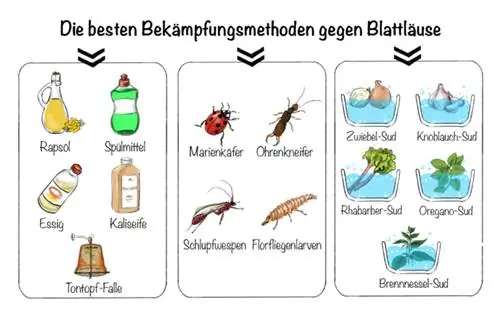
Fighting black aphids - home remedies
While beneficial insects don't bother you in the garden, other means are needed in the home. There are a number of home remedies you can use to combat sucking insects on houseplants. It is important that you carry out the measures regularly. Otherwise not all insects will be detected and the plague will occur again.
Black aphids can be easily controlled with home remedies.
Intensely scented culinary herbs
For a light infestation, it is enough to stick a peeled clove of garlic into the soil of the affected plants. If the lice have developed large colonies, a self-mixed decoction of garlic will help. Let a crushed clove of garlic steep in a liter of water for about two weeks and then spray the aphid colonies with the decoction.
Recipe for oregano broth:
- Pour ten grams of dried herb into a container
- pour one liter of boiled water over it
- let it cool down and strain out the remaining herbs
- Dilute the broth with water in a ratio of 1:3
- spray thoroughly on the underside of the leaves and stems
potassium soap
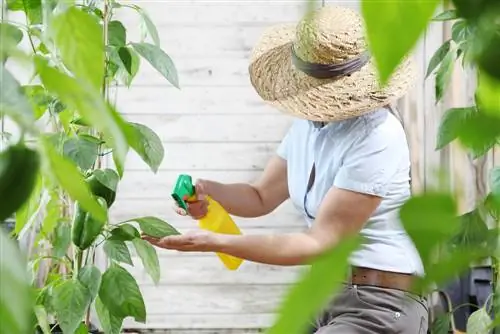
Soap solution or black tea is not good for aphids
This medical soft soap is made from linseed oil and potassium hydroxide. It is used to control pests and is not dangerous to larger insects such as bees. Dilute 20 grams of the soap with one liter of water and spray the solution onto the affected parts of the plant. Sensitive plants can be damaged by the treatment, so as a precaution you should test the product on a small area of leaves.
Tip
Treatment with black tea is particularly suitable for sensitive plants. It contains tannins that kill aphids.
Herbal sprays
Plants produce various substances such as essential oils or tannic acids to protect themselves from predators. These can be extracted by boiling the plant parts in water or letting them steep for several days. The decoctions are sprayed over a large area onto the affected plants using an atomizer. If necessary, the treatment must be repeated several times. These plants are particularly suitable against black aphids:
| Preparation | Application | Suitability | |
|---|---|---|---|
| Rhubarb | Boil 500 grams of leaves in three liters of water for 30 minutes | filtered and undiluted | e.g. Tomatoes, roses |
| Onion | Simmer diced onion in a liter of water for 30 minutes | filtered and undiluted | especially for roses |
| Stinging Nettle | Pour hot water over half a bucket of leaves and let it steep | filtered and undiluted | Ornamental and useful plants |
Cleaning supplies
Wine vinegar and dish soap prove to be effective control agents, which are diluted and sprayed onto the aphid colonies. Mix 500 milliliters of vinegar with about four liters of water and add a few squirts of dish soap. This ensures that the aphids can no longer hold on to the plant parts. After one application, wait at least three days before the next application. Alternatively, sensitive plants such as roses and orchids can be treated with a dish soap and water solution without vinegar.
Tip
A solution of rapeseed oil, water and a few drops of dish soap works wonders against aphids. The agent blocks the breathing openings and prevents the aphids from adhering to the substrate.
Frequently asked questions
In one year, treatment with plant broths achieves good results, in others they do not help against black aphids. What could be the reason?
It depends on which plant parts you collect and use at what time of year. Depending on the weather and time, the concentrations of effective ingredients vary. They usually rise from spring and reach their peak in summer before the ingredients are slowly broken down again. After longer dry phases, the active ingredient content is also higher. Many plants produce more substances in the sun than their counterparts that grow in partial shade under less light conditions.
Are there different types of black aphids?
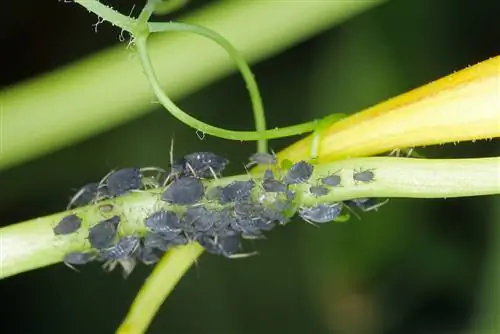
The black bean louse is particularly common
There are various black-colored species that are predominantly wingless. When food becomes scarce, generations of small black aphids with wings develop. However, if you look for black aphids on Wikipedia, you will hardly find anything. The pests represent a species-rich subfamily, of which 850 different species occur in Central Europe. Black bean aphid (Aphis fabae) and cherry aphid (Myzus cerasi), which are also black in color, are widespread.
Where do black aphids appear?
The plant pests attack various herbaceous plants and vegetables in kitchen and ornamental gardens. They occur on beans, beets, potatoes or tomatoes and can occur on cherry trees and herbaceous plants such as parsley, poppies, goosefoot or jewelweed.
What to do to prevent an aphid infestation?
Pay attention to mixed crops in the garden, as this creates a natural balance between beneficial insects and pests. A balanced supply of nutrients is important because aphids prefer to spread on weakened plants. Apply a white coat to the trunks of fruit trees and, as a precaution, spray a rapeseed oil-water mixture in the spring.

